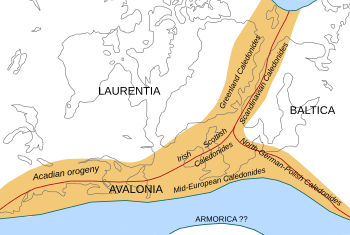Our website is made possible by displaying online advertisements to our visitors.
Please consider supporting us by disabling your ad blocker.
Caledonian orogeny

The Caledonian orogeny was a mountain-building cycle recorded in the northern parts of the British Isles, the Scandinavian Caledonides, Svalbard, eastern Greenland and parts of north-central Europe. The Caledonian orogeny encompasses events that occurred from the Ordovician to Early Devonian, roughly 490–390 million years ago (Ma). It was caused by the closure of the Iapetus Ocean when the Laurentia and Baltica continents and the Avalonia microcontinent collided.
The orogeny is named for Caledonia, the Latin name for Scotland. The term was first used in 1885 by Austrian geologist Eduard Suess for an episode of mountain building in northern Europe that predated the Devonian period. Geologists like Émile Haug and Hans Stille saw the Caledonian event as one of several episodic phases of mountain building that had occurred during Earth's history.[2] Current understanding has it that the Caledonian orogeny encompasses a number of tectonic phases that can laterally be diachronous, meaning that different parts of the mountain range formed at different times. The name "Caledonian" can therefore not be used for an absolute period of geological time, it applies only to a series of tectonically related events.
- ^ Reconstruction based on Matte 2001; Stampfii, von Raumer & Borel 2002; Torsvik et al. (1996) and Ziegler (1990)
- ^ McKerrow et al. (2002)
Previous Page Next Page


